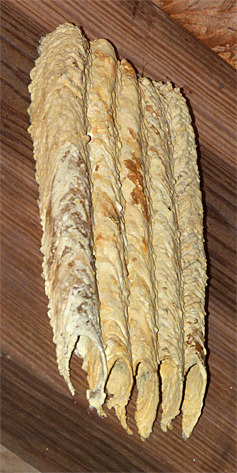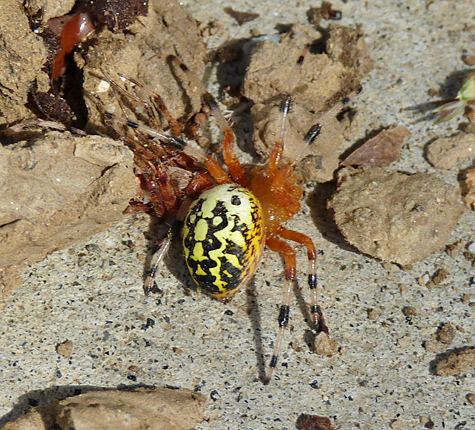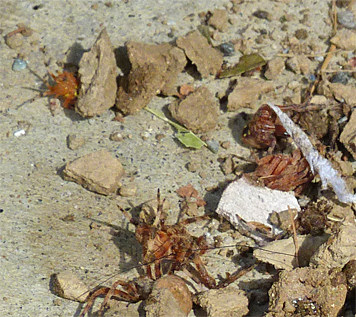
You have no doubt seen the object, or one like it, in the photo at right. It’s an Organ Pipe Mud Dauber’s nest. One individual constructed the “pipes” in the photo, a female wasp. The male may be nearby to guard the nest but doesn’t participate in its construction.
Each pipe may have anywhere from several to a dozen cells within. The cells are stocked with spiders which the female paralyzes with venom from her stinger. Once stocked with spiders, eggs are laid in the cells. The larvae that hatch from the eggs consume the still alive, but paralyzed, spiders. Gruesome perhaps, but no more so than what spiders do to the creatures that happen into their webs, they wrap them up tightly in silk and save them for later, still alive in their silken suits.
As mentioned, the male doesn’t participate in the nest construction but he’s usually nearby to help protect the nest. If the nest is disturbed he may make a very loud buzzing sound, but it’s all show, a lot of noise. The male couldn’t sting you if he wanted to, he has no stinger!
The female herself, who does have a stinger, will probably not sting either if you happen to get too near the nest. Mud daubers are solitary wasp. The stingers of solitary wasps are meant to secure prey for their young, to paralyze prey, such as spiders, in order to stock the nest with food for their growing young.
Unlike yellow jackets and hornets who’ll come storming after you if you look at them funny, you have to treat mud daubers in a fairly rough manner to get them to sting. I usually tell folks that “you’d have to poke one in the eye to get ’em to sting you,” although I don’t recommend poking at their eyes, or anywhere else on their little wasp bodies.
Most solitary wasps are considered beneficial creatures because they remove unwanted pests from the environment, like grasshoppers and other plant eating insects. However, I don’t see much benefit in removing spiders from the food chain. Spiders consume a variety of harmful insects. I think perhaps the only benefit this wasp performs is to itself. They are though, certainly not harmful to us, so let them be, and they will let you be.
Below is a photo of an Organ Pipe Mud Dauber’s nest which was removed from a wall directly over a doorway here at the Museum, a perfect oportunity to have a look inside. The nest had one complete “pipe” and two incomplete “pipes.”

It’s early in the season for spiders and most of the spiders in the cells are small versions of what they would have become in late summer and fall.


These gentle (to us) wasps will not harm you, are fascinating to watch, and unless you really don’t like the appearance of the organ pipes, there’s no reason to remove them from your house, shed, or under your deck. Of course, if you have a special fondness for spiders, you may not agree. I think, though, that there are probably more folks out there who would rather a few less arachnids wandering around their backyards.
I’m the type who likes spiders and I take these down and squash the little victims since they can’t be saved.
But doesn’t spider venom digest the innards of insects? It seems like the spider prey would die pretty quick being digested like that.
Intersting story, to me at least. I stole a very large wolf spider being drug off from a wasp. Put It on my shelf. Over time it began moving more and more and could go maybe an inch. Seemed to drink from a droplet after a couple of weeks. It began moving each leg up and down in a way that reminded me of tarantula behavior before molting. It also groomed it’s fangs, if thatscwhat you call it when they move them and brush forelegs against. I thought things were looking better for it but one morning it was legs curled up tight and dead.
Your right, death is probably quicker for the victims of a spider. But, I’ve noticed that whatever happens to get caught in the webs of spiders struggles mightily to get out, and the spider doesn’t actually bite the victim until it has wrapped it up in silk, correct? Either way, I would not want to be victim to either spider or wasp!
And yes, that is an interesting story of your trying to save, or at least observe, the wolf spider after having been stung by the wasp.
Thanks for sharing.